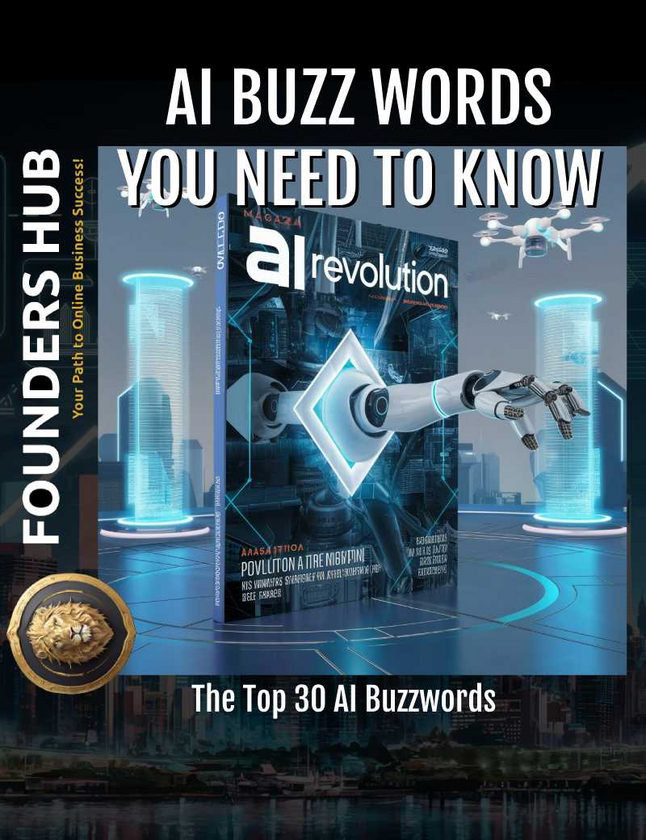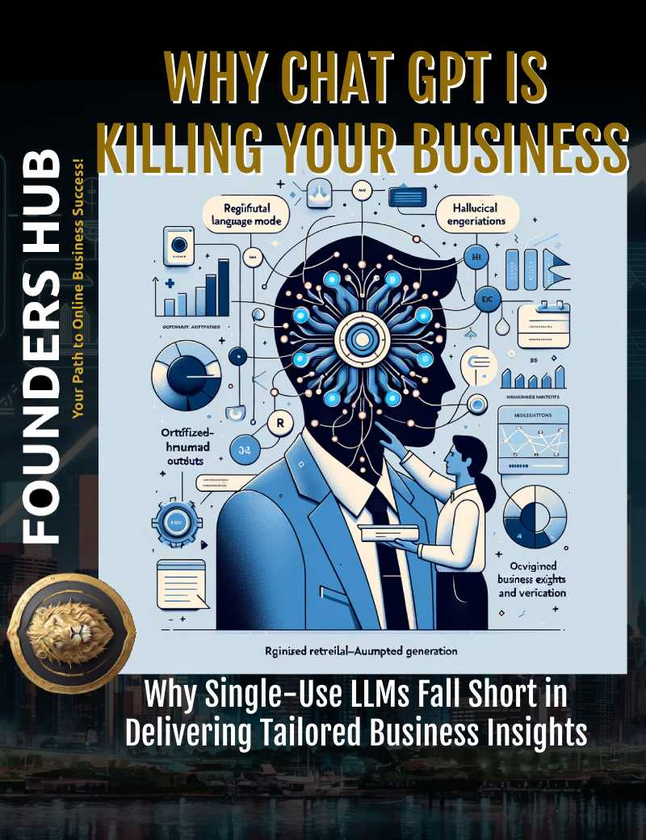The world of artificial intelligence is rapidly evolving, with a dizzying array of buzzwords and technical terms that can make it hard to keep up. But fear not, we've compiled a comprehensive guide to 30 of the most important AI buzzwords you need to know. From A/B testing to Voice AI, we'll break down each term in detail and explain how these cutting-edge technologies are transforming industries across the board.
> Key Takeaway:, We'll provide a high-level introduction to the key AI concepts covered in this post, including machine learning, natural language processing, intelligent automation, and more. Whether you're a business leader, tech enthusiast, or simply curious about the latest advancements in AI, you won't want to miss this insider's guide to the future of technology.
1 A/B Testing:
A/B testing is a method of comparing two versions of a product, feature, or marketing campaign to determine which one performs better. It involves randomly showing users one of the two versions and measuring the differences in user behavior or conversion rates. This data-driven approach helps businesses make informed decisions and optimize their offerings.
2 Agent Assist:
Agent Assist is a technology that provides real-time support and guidance to customer service agents, enabling them to handle customer inquiries more efficiently. It uses natural language processing and machine learning to understand the context of the conversation, provide relevant information, and suggest appropriate responses. This can lead to improved customer satisfaction and reduced training time for agents.
3 AI Virtual Assistant:
An AI Virtual Assistant is an artificial intelligence-powered software application that can engage in natural language conversations and perform various tasks on behalf of users. These assistants can be accessed through voice, text, or chat interfaces and can help with a wide range of activities, such as scheduling appointments, setting reminders, answering questions, and providing personalized recommendations.
4 Artificial Intelligence (AI):
Artificial Intelligence (AI) refers to the broad field of study and development of computer systems capable of performing tasks that typically require human intelligence, such as learning, problem-solving, decision-making, and natural language understanding. AI systems can be trained on large datasets to recognize patterns, make predictions, and automate various processes.
5 Augmented Reality (AR):
Augmented Reality (AR) is a technology that overlays digital information, such as images, 3D models, or interactive elements, onto the user's real-world environment. AR enhances the user's perception and experience of the physical world by blending virtual and physical elements seamlessly. This technology has applications in various industries, including gaming, retail, education, and industrial automation.
6 Chatbot:
A Chatbot is an AI-powered conversational interface that can engage in natural language interactions with users. Chatbots are designed to understand user input, interpret their intent, and provide relevant responses, often automating customer service or information-gathering tasks. They can be integrated into various platforms, such as websites, messaging apps, or virtual assistants.
7 Customer Relationship Management (CRM):
Customer Relationship Management (CRM) is a strategy and technology that helps businesses manage their interactions with customers, prospects, and partners. CRM systems typically include features for tracking and organizing customer data, automating sales and marketing processes, and providing insights to improve customer experience and retention.
8 Cognitive Computing:
Cognitive Computing refers to the development of computer systems that can mimic the human brain's ability to perceive, learn, reason, and interact. These systems leverage technologies like natural language processing, machine learning, and knowledge representation to understand and respond to complex, unstructured data in a more human-like manner. Cognitive computing has applications in areas such as decision support, predictive analytics, and personalized recommendations.
9 Conversational Artificial Intelligence (AI):
Conversational Artificial Intelligence (AI) refers to the development of AI systems that can engage in natural language conversations with humans. These systems use natural language processing, machine learning, and dialogue management to understand user input, interpret their intent, and provide relevant and contextual responses. Conversational AI powers chatbots, virtual assistants, and other interactive interfaces.
10 Deep Learning:
Deep Learning is a subfield of machine learning that involves the use of artificial neural networks with multiple hidden layers to learn and make predictions from complex data. Deep learning models can automatically extract features and patterns from large datasets, enabling them to tackle a wide range of tasks, such as image recognition, natural language processing, and speech recognition.
11 Generative AI:
Generative AI refers to a class of AI models that can create new, original content, such as text, images, audio, or video, based on the input they receive. These models, which include technologies like Generative Adversarial Networks (GANs) and Variational Autoencoders (VAEs), can be used for tasks like content generation, data augmentation, and creative applications.
12 Generator:
In the context of AI, a Generator is a type of model or component within a generative AI system that is responsible for producing new, synthetic data. Generators are often paired with a Discriminator model in a Generative Adversarial Network (GAN) architecture, where the Generator learns to create realistic outputs that can fool the Discriminator.
13 Generative Pre-trained Transformer (GPT):
Generative Pre-trained Transformer (GPT) is a type of large language model developed by OpenAI that uses the Transformer architecture to generate human-like text. GPT models are pre-trained on massive amounts of text data and can be fine-tuned for a variety of natural language processing tasks, such as text generation, question answering, and text summarization.
14 Hyper-personalization:
Hyper-personalization is the process of tailoring products, services, and experiences to individual users based on their unique preferences, behaviors, and context. It goes beyond traditional personalization by leveraging advanced technologies like AI, machine learning, and real-time data analysis to create highly personalized and relevant interactions at scale.
15 Intelligent Automation (IA):
Intelligent Automation (IA) is the integration of automation technologies, such as robotic process automation (RPA) and artificial intelligence, to automate and optimize business processes. IA can help organizations streamline workflows, reduce errors, and improve efficiency by automating repetitive, rule-based tasks and leveraging AI for more complex decision-making and problem-solving.
16 Intelligent Virtual Agent (IVA):
An Intelligent Virtual Agent (IVA) is an AI-powered conversational interface that can engage in natural language interactions with users, similar to a chatbot or virtual assistant. However, an IVA is typically more advanced, with the ability to understand context, learn from interactions, and provide personalized responses and recommendations.
17 Internet of Things (IoT):
The Internet of Things (IoT) refers to the network of connected devices, sensors, and objects that can collect and exchange data over the internet. IoT technologies enable the automation and optimization of various processes, from smart home systems to industrial automation, by gathering and analyzing real-time data from these connected devices.
18 Knowledge Management (KM):
Knowledge Management (KM) is the process of creating, sharing, using, and managing the knowledge and information of an organization. KM systems and technologies, such as knowledge bases, document management, and collaboration tools, help organizations capture, organize, and disseminate knowledge to improve decision-making, problem-solving, and innovation.
19 Machine Learning (ML):
Machine Learning (ML) is a field of artificial intelligence that enables computer systems to learn and improve from experience without being explicitly programmed. ML algorithms can analyze data, identify patterns, and make predictions or decisions based on that data, without relying on rule-based programming.
20 Natural Language Processing (NLP):
Natural Language Processing (NLP) is a subfield of artificial intelligence that focuses on the interaction between computers and human language. NLP techniques and models are used to analyze, understand, and generate human language, enabling applications such as text classification, sentiment analysis, language translation, and conversational interfaces.
21 Predictive Analytics:
Predictive Analytics refers to the use of statistical models, machine learning algorithms, and data mining techniques to analyze current and historical data to make predictions about future events, behaviors, or outcomes. Predictive analytics can help organizations make more informed decisions, optimize processes, and anticipate customer needs.
22 Real-time Analytics:
Real-time Analytics is the process of analyzing data and generating insights as soon as the data is generated or collected, rather than waiting for a batch processing or scheduled analysis. This enables organizations to make faster, more informed decisions and respond to changing conditions or customer needs in real-time.
23 Robotic Process Automation (RPA):
Robotic Process Automation (RPA) is a technology that allows organizations to automate repetitive, rule-based tasks and processes by using software "robots" or "bots" to mimic human actions. RPA can help improve efficiency, reduce errors, and free up employees to focus on more strategic, value-added work.
24 Self-service:
Self-service refers to the ability of customers, employees, or users to access information, perform tasks, or resolve issues without the direct assistance of a human representative. Self-service technologies, such as knowledge bases, chatbots, and online portals, empower users to find answers, complete transactions, and manage their own needs, improving convenience and reducing the burden on support teams.
25 Sentiment Analysis:
Sentiment Analysis is the process of using natural language processing, text analysis, and machine learning techniques to identify, extract, and quantify the sentiment or emotional tone expressed in text data. This includes determining whether a piece of text, such as a customer review, social media post, or customer support interaction, conveys a positive, negative, or neutral sentiment. Sentiment analysis can provide valuable insights into customer opinions, brand perception, and market trends, enabling organizations to make more informed decisions.
26 Social Listening:
Social Listening is the process of monitoring social media platforms and online conversations to identify and analyze relevant mentions, comments, and discussions about a brand, product, industry, or topic. This information can be used to gain insights into customer sentiment, identify trends, and inform marketing, customer service, and product development strategies.
27 Social Media Monitoring:
Social Media Monitoring is the practice of tracking and analyzing activity on social media platforms to understand how a brand, product, or industry is being discussed and perceived. This includes monitoring mentions, comments, shares, and other engagement metrics to gather insights that can inform marketing, customer service, and reputation management efforts.
28 Speech Recognition:
Speech Recognition, also known as Automatic Speech Recognition (ASR), is the ability of a computer system or software application to identify and transcribe spoken language into text. Speech recognition technology enables hands-free, voice-based interactions with devices and applications, powering features like voice commands, virtual assistants, and speech-to-text transcription.
29 Transformer:
In the context of natural language processing, a Transformer is a type of deep learning model that uses an attention mechanism to process sequential data, such as text, without relying on recurrent neural networks. Transformers have become a popular architecture for tasks like language translation, text generation, and question answering, as they can capture long-range dependencies more effectively than traditional models.
30 Voice Artificial Intelligence (Voice AI):
Voice Artificial Intelligence (Voice AI) refers to the integration of AI technologies, such as speech recognition, natural language processing, and text-to-speech, to enable voice-based interactions and control. Voice AI powers virtual assistants, smart speakers, and other voice-enabled devices and applications, allowing users to perform tasks, access information, and control their environment using voice commands.
Want to learn more about how AI can benefit your business and when and where to use it?
Then check out the Generative AI Lab



















